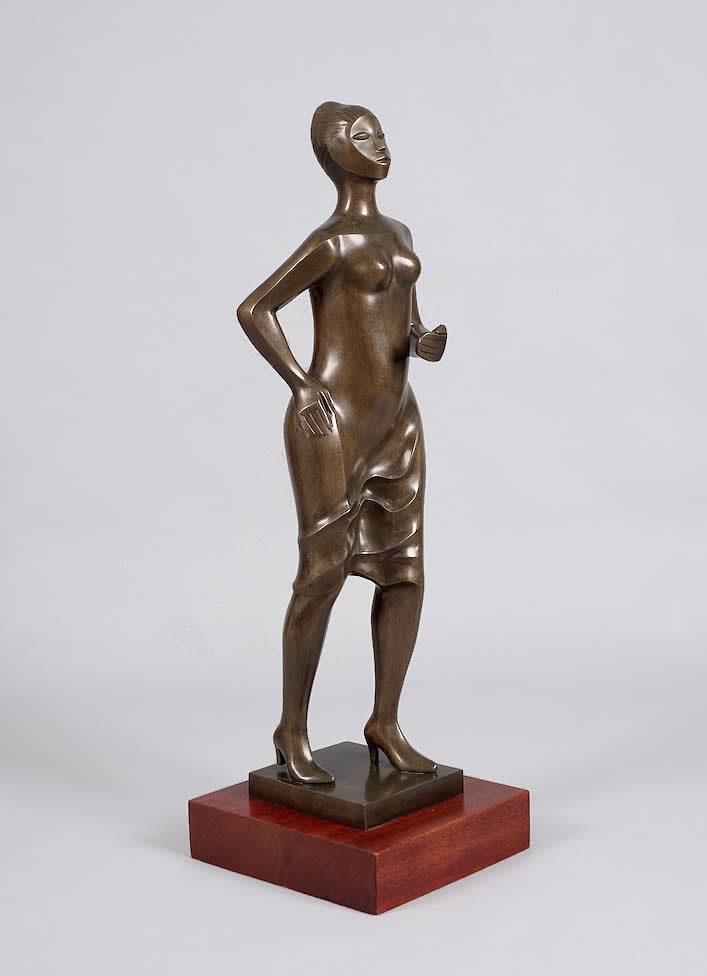



artist
Elizabeth Catlett is one of the most significant African American sculptors and printmakers of the twentieth and twenty-first centuries. Inspired by her grandmother's stories of slavery and female resistance, she was an early advocate of women's liberation and the empowerment of African Americans. She was a powerful speaker, who through her actions and her art greatly influenced the younger generations of African American artists who came after her.
Catlett was born in 1915 in Washington D.C., the youngest of three children of John and Mary Carson Catlett, both schoolteachers. Her father died soon after she was born and her mother and paternal grandmother raised her. From a young age, Catlett enjoyed drawing and painting and she knew in high school that she wanted to become an artist. She won a competition for a scholarship to the Carnegie Institute of Technology in Pittsburgh, but was rejected because she was African American. Encouraged by her mother, she attended Howard University, where she initially studied textile design before changing her major to painting.
Catlett would go on to receive the first Master's in Fine Arts from the State University of Iowa. She studied under Grant Wood, whose influence she described in her own words: “Grant Wood, one of the first white people that I had contact with, emphasized that we should paint what we knew most intimately...and my people have always been just that – what I knew most intimately” (Romare Bearden and Harry Henderson, A History of African American Artists: From 1792 to the Present, New York, 1993, p. 421). For this reason, she chose a black mother and child as the subject of her master's degree thesis in 1940. This 35 ½ inch high sculpture in limestone won her first prize in sculpture at the American Negro Exposition in Chicago. There she met Charles White, another artist, and they married in 1941.
In 1942, Catlett and White moved to New York and lived in Harlem. The Harlem of the 1940s was a much different place than 10 years earlier during the Harlem Renaissance, when the WPA-sponsored Harlem Community Art Center thrived, and African American artists, musicians, and writers flourished. Catlett worked at the populist George Washington Carver School and embraced its mission. Here she met “the kind of people I had never been in contact with before. I came from a middle-class family, even though my mother had to work hard. But the school brought me into contact with working people. For the first time I began to get an understanding of the great hunger for art and culture of ordinary black people” (Bearden and Henderson, p. 422).
In New York, Catlett studied under Ossip Zadkine at the Art Students League. She observed Zadkine's technique in working with terra cotta and she was stylistically influenced by him as well. Zadkine encouraged her to develop her work in a more abstract direction. Catlett was also influenced by pre-Columbian sculpture, Henry Moore’s sensuous reclining nudes, and Diego Rivera’s political murals.
A Rosenwald Fund fellowship brought Catlett to Mexico in 1946, where she worked on her famous series of linoleum cuts, The Negro Woman. During her fellowship, she studied with Francisco Zuniga, one of Mexico's leading sculptors. He taught her techniques of ceramic sculpture that dated back to pre-Hispanic times. She studied wood carving and was an active member of the Taller de Gráfica Popular. Catlett thrived in Mexico and would remain there for decades after she married artist Francisco Mora (she and White divorced in 1946). Her three sons were born there and she became a Mexican citizen in 1962.
Catlett focused almost exclusively on African American women as the subject of her sculptures. She was highly capable in working with varied materials, including mahogany, limestone, cedar, bronze, black marble and terra cotta. No matter the material, Catlett’s women are always strong, powerful figures, often shown with their heads titled upwards, depicting Catlett’s belief in their ability to persevere and overcome life’s struggles. As she told a former student, the artist and art historian Samella S. Lewis, “I have always wanted my art to service my people — to reflect us, to relate to us, to stimulate us, to make us aware of our potential.”
provenance
Private Collection, Mexico
Purchased from above by Robert Bijou



